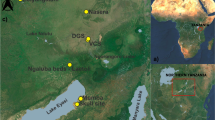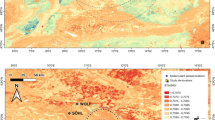Abstract
Three hominin phalanges were recently identified in old faunal collections attributed to the Late Acheulean (Layer D2) dated to ca. 213 Kya, from Oumm Qatafa Cave (Judean Desert), a site excavated in 1928–1949. In terms of general appearance (colour, patina and adhering sediment), these specimens resembled the fauna with which they were found, but the likelihood of stratigraphic problems especially in old excavations, the presence of 4th millennium b.c. burials in the topmost Layer A at the site and the absence of any mention of Late Acheulean hominin remains in publications relating to the site prompted us to verify that the phalanges were indeed in situ. Osteometric examination showed the phalanges to be indistinguishable from those of Middle Paleolithic Levantine anatomically modern humans (AMHS) as well as Upper Paleolithic and recent populations, thus contributing little to the resolution of their provenance. To further investigate this issue, we compared the elemental composition of the phalanges to that of fauna from the same and overlying archaeological layers using non-destructive laser ablation–inductively coupled plasma mass spectrometry (LA-ICP-MS). The results showed a close resemblance in elemental composition between the phalanges and fauna from Layer D2, implying that they are in situ. This would indicate either an early occurrence of AMHS in the region or the presence of an ancestral archaic Homo. We propose that LA-ICP-MS offers a useful minimally invasive method for provenancing isolated human and faunal remains.










Similar content being viewed by others
References
Alexeev VP (1966) Osteometria. Nauka, Moskva, pp 129–130, 202–203 (in Russian)
Balek CL (2002) Buried artifacts in stable upland sites and the role of bioturbation: a review. Geoarchaeology 17(1):41–51
Bentor Y (1951) Etude pétrographique des roches de la grotte d’Oumm-Qatafa. In: Neuville R (ed) Paléolithique et Mésolithique du Désert de Judée. Archives de l’Institut de Paléontologie Humaine 24, Paris, pp 24–197
Beyth M, Shirav M, Halicz L, Bogosh R (1988) Geochemical orientation survey of Har Timna, Southern Israel. Geological Survey of Israel, Report GSI/15/88
Bulska E, Wagner B, Walaszek D, Halicz L, Segal I (2009) Determination of elemental composition of apatite crystals by LA-ICP-MS. Abstract 36th Coloquium Spectroscopicum Internationale, Budapest, Hungary
Case DT, Heilman J (2006) New siding techniques for the manual phalanges: a blind test. Int J Osteoarchaeol 16:338–346
Castro W, Hoogewerff J, Latkoczy C, Almirall JR (2010) Application of laser ablation (LA-ICP-SF-MS) for the elemental analysis of bone and teeth samples for discrimination purposes. Forensic Sci Int 195:17–27
Christensen AM (2009) Techniques for siding manual phalanges. Forensic Sci Int 193:84–87
Courtaud P, Tillier AM (2005) À propos de vestiges humains immatures inédits provenant des niveaux moustériens de Qafzeh. Bull Mém Soc Anthropol Paris 17(1–2):37–45
Dogan A, Uslu M, Aydinlioglu A, Harman M, Akpinar F (2007) Morphometric study of the human metatarsals and phalanges. Clin Anat 20:209–214
Evans A, Langer J, Donahue R, Wolframm Y, Lovis W (2010) Lithic raw material sourcing and the assessment of Mesolithic landscape organization and mobility strategies in northern England. The Holocene 20:1157–1163
Gilbertson D, Bird M, Hunt C, McLaren S, Mani Banda R, Pyatt B, Rose J, Stephens M (2005) Past human activity and geomorphological change in a guano-rich tropical cave mouth: initial interpretations of the Late Quaternary succession in the Great Cave of Niah, Sarawak. Asian Perspect 44(1):16–41
Gilead D (1970) Early Palaeolithic cultures in Israel and the Near East. Unpublished PhD thesis, Hebrew University, Jerusalem
Gopher A, Ayalon A, Bar-Matthews M, Barkai R, Frumkin A, Karkanas P, Shahack-Gross R (2010) The chronology of the late Lower Paleolithic in the Levant based on U–Th ages of speleothems from Qesem Cave, Israel. Quat Geochron 5:644–656
Grandstaff DE, Terry DO Jr (2009) Rare earth element composition of Paleogene vertebrate fossils from Toadstool Geologic Park, Nebraska, USA. Appl Geochem 24:733–745
Grün R, Beaumont P (2001) Border Cave revisited: a revised ESR chronology. J Hum Evol 40(6):467–482
Haas G (1951) Remarque sur la microfaune de mammifères de la Grotte de Oumm-Qatafa. In: Neuville R (ed) Paléolithique et Mésolithique du Désert de Judée. Archives de l’Institut de Paléontologie Humaine 24, Paris, pp 218–233
Hershkovitz I, Smith P, Sarig R, Quam R, Rodríguez L, García R, Arsuaga JL, Barkai R, Gopher A (2010) Middle Pleistocene dental remains from Qesem Cave (Israel). Am J Phys Anthropol. doi:10.1002/ajpa.21446
Iyengar V, Wolttiez J (1988) Trace elements in human clinical specimens: evaluation of literature data to identify reference values. Clin Chem 34(3):474–481
Kondo O, Dodo Y (2002) The postcranial bones of the Neanderthal child of the Burial No. 1. In: Akazawa T, Muhesen S (eds) Neanderthal burials—excavations of the Dederiyeh Cave Afrin, Syria. International Research Center for Japanese Studies, Kyoto, pp 139–214
Lorenzo C, Arsuaga JL, Carretero JM (1999) Hand and foot remains from the Gran Dolina Early Pleistocene site (Sierra de Atapuerca, Spain). J Hum Evol 37:501–522
MacFadden BJ, Hulbert RC Jr (2009) Calibration of mammoth (Mammuthus) dispersal into North America using rare earth elements of Plio-Pleistocene mammals from Florida. Quat Res 71:41–48
Martin R, Saller K (1957) Lehrbuch der anthropologie, Band I, 3rd edn. Gustav Fischer, Stuttgart, pp 554–589
Martin JE, Patrick D, Kihrn AJ, Foit FF, Grandstaff DE (2005) Lithostratigraphy, tephrochronology and rare earth element geochemistry of fossils at the classical Pleistocene Fossil Lake area, South Central Oregon. J Geol 119:139–155
Matsu’ura S, Kondo M, Aziz F, Sudijono NS, Watanabe N (2000) First known tibia of an early Javanese hominid. Curr Anthropol 41(2):297–300
Metzger CA, Terry DO Jr, Grandstaff DE (2009) Effect of paleosol formation on rare earth element signatures in fossil bone. Geol 32:497–500
McCown TD, Keith A (1939) The fossil human remains from the Levalloiso-Mousterian. In: Garrod DAE, Bate DMA (eds) The stone age of Mount Carmel, vol II. Claredon, Oxford, pp 139–237
Mercier N, Valladas H, Froget L, Joron J-L, Ronen A (2000) Datation par thermoluminescence de la base du gisement paléolithique de Tabun (Mont Carmel. Israël). C R Acad Sci 330:731–738 (Paris)
Millard A (2006) Comment on Martínez-García et al. “Heavy metals in human bones in different historical epochs”. Sci Total Environ 354:295–297
Miller Rosen A (2007) Civilizing climate. Altamira, Plymouth
Moyà-Solà S, Köhler M, Alba DM, Almécija S (2008) Taxonomic attribution of the Olduvai Hominid 7 manual remains and the functional interpretation of hand morphology in robust australopithecines. Folia Primatol 79:215–250
Musgrave JH (1973) The phalanges of Neanderthal and Upper Palaeolithic hands. In: Day MH (ed) Human evolution. Taylor and Francis, London, pp 59–85
Neuville R (1931) L’Acheuléen supériere de la grotte d’Oumm Qatafa (Palestine). L’Anthropol 41(13–51):249–263
Neuville R (ed) (1951) Paléolithique et Mésolithique du Désert de Judée. Archives de l’Institut de Paléontologie Humaine 24, Paris
Neuville R, Boureau R (1930) Squelettes palestiniens du premier âge du Bronze. Bull Mém Soc’Anthropol Paris 1(4–6):33–36
Neuville R, Mallon A (1931) Les debuts de l’age des metaux dans les grottes du désert de Judée. Syria 12:24–47
Nielsen AE (1991) Trampling the archaeological record: an experimental study. Am Antiquity 56(3):483–503
Parish JG (1966) Radiographic measurements of the skeletal structure of the normal hand. Br J Radiol 39:52–62
Perrot J (1992) Umm Qatafa and Umm Qala’a: two Ghassulian caves in the Judean desert. Eretz-Israel 23:100*–111*
Pike AWG (2000) U-series dating of archaeological bone using TIMS. PhD thesis, University of Oxford
Pike AWG, Eggins S, Grün R, Thackeray F (2004) U-series dating of TP1, an almost complete human skeleton from Tuinplaas (Springbok Flats), South Africa. S Afr J Sci 100(7–8):381–383
Plummer TW, Kinyua AM, Potts R (1994) Provenancing of hominid and mammalian fossils from Kanjera, Kenya, using EDXRF. J Archaeol Sci 21:553–563
Plummer T, Potts R (2005) Hominid fossil sample from Kanjera, Kenya: description, provenance, and implications of new and earlier discoveries. Am J Phys Anthropol 96(1):7–23
Porat N (2007) Luminescence and electron spin resonance dating. In: Chazan M, Horwitz LK (eds) Holon: a Lower Paleolithic site in Israel. Peabody Museum, Cambridge, pp 17–26
Porat N, Chazan M, Schwarcz HP, Horwitz LK (2002) Timing of the Lower to Middle Paleolithic transition in the Levant: evidence from new dates. J Hum Evol 43:107–122
Russo RE, Mao X, Liu H, Gonzalez J, Mao SS (2002) Laser ablation in analytical chemistry—a review. Talanta 57:425–451
Schiffer MB (1987) Formation processes of the archaeological record. University of New Mexico Press, Albuquerque
Schwarcz HP, Goldberg P, Blackwell B (1980) Uranium series dating of archaeological sites in Israel. Isr Earth Sci 29:157–165
Shea J (2003) The Middle Paleolithic of the East Mediterranean Levant. J World Prehist 17:313–394
Speakman RJ, Glascock MD, Tykot RH, Descantes C, Thatcher JJ, Skinner CE, Lienhop KM (2007) Selected applications of laser ablation inductively coupled plasma–mass spectrometry to archaeological research. In: Glascock MD, Speakman RJ, Popelka-Filcoff RS (eds) Archaeological chemistry: analytical methods and archaeological interpretation, ACS Publication Series 968. American Chemical Society, Washington, pp 275–296
Susman RL (2008) Evidence bearing on the status of Homo habilis at Olduvai Gorge. Am J Phys Anthropol 137:356–361
Takata MK, Saiki M, Sumita NM, Saldiva PHN, Pasqualucci CA (2005) Trace element determinations in human cortical and trabecular bones. J Radioanal Nucl Chem 264(1):5–8
Tchernov E (1988) The paleobiogeographical history of the southern Levant. In: Yom-Tov Y, Tchernov E (eds) The zoogeography of Israel. Junk, Dordrecht, pp 159–250
Tillier AM (1999) Les enfants moustériens de Qafzeh. Interprétation phylogénétique et paléoauxologique. Cahiers de Paléoanthropologie, CNRS Éditions, Paris
Trinkaus E, Hilton CE (1996) Neanderthal pedal proximal phalanges: diaphyseal loading patterns. J Hum Evol 30:399–425
Trueman CN (1999) Rare earth element geochemistry and taphonomy of terrestrial vertebrate assemblages. Palaios 14:555–568
Trueman CN, Benton MJ (1997) A geochemical method to trace the taphonomic history of reworked bones in sedimentary settings. Geology 5:263–266
Trueman CN, Behrensmeyer AK, Tuross N, Weiner S (2004) Mineralogical and compositional changes in bones exposed on soil surfaces in Amboseli National Park, Kenya: diagenetic mechanisms and the role of sediment pore fluids. J Archaeol Sci 31:721–739
Trueman CN, Behrensmeyer AK, Potts R, Tuross N (2006) High-resolution records of location and stratigraphic provenance from the rare earth element composition in fossil bones. Geochim Cosmochim Acta 70:4343–4355
Vandermeersch B (1981) Les Hommes Fossiles de Qafzeh (Israël). Editions du CNRS, Paris
Vaufrey R (1951) Etude Paléontologique. In: Neuville R (ed) Paléolithique et Mésolithique du désert de Judée. Archives de l’Institut de Paléontologie Humaine 24, Paris, pp 198–217
Villa P (1982) Conjoinable pieces and site formation processes. Am Antiquity 47:276–310
Villa P, Courtin J (1983) The interpretation of stratified sites: a view from underground. J Archaeol Sci 10(3):267–281
Weiner S, Bar-Yosef O (1990) States of preservation of bones from prehistoric sites in the Near East: a survey. J Archaeol Sci 17:187–196
Acknowledgements
We would like to offer our appreciation and give credit to Emma Humphreys (PhD candidate, Department of Anthropology, University of Toronto) who originally found the phalanges whilst cataloguing the Oumm Qatafa fauna. Our sincere thanks is also extended to: Dr. Clive Trueman and an anonymous reviewer for their valuable suggestions, which greatly improved the manuscript; to Dr. Rivka Rabinovich, curator of the archaeozoological collections at The Hebrew University of Jerusalem, for facilitating access to LKH to study the Oumm Qatafa fauna; and to Mr. Vladimir Nakhlin (photography) and Mr. Leonid Zeiger (phalanx drawing).
Author information
Authors and Affiliations
Corresponding author
Electronic supplementary material
Below is the link to the electronic supplementary material.
Online Fig. 1
(GIF 186 kb)
Online List 1
(DOC 33 kb)
Online References
(DOC 28 kb)
Online Table 1
(DOC 35 kb)
Online Table 2
(DOC 44 kb)
Online Table 3
(DOC 31 kb)
Rights and permissions
About this article
Cite this article
Horwitz, L.K., Smith, P., Faerman, M. et al. The application of biometry and LA-ICP-MS to provenance isolated bones: a study of hominin remains from Oumm Qatafa Cave, Judean Desert. Archaeol Anthropol Sci 3, 245–262 (2011). https://doi.org/10.1007/s12520-011-0056-1
Received:
Accepted:
Published:
Issue Date:
DOI: https://doi.org/10.1007/s12520-011-0056-1




